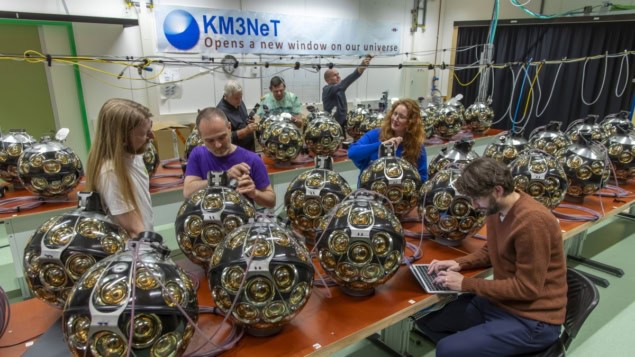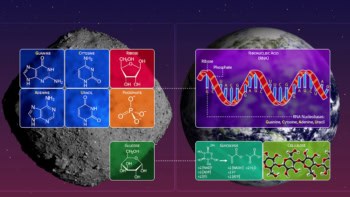
Using an observatory located deep beneath the Mediterranean Sea, an international team has detected an ultrahigh-energy cosmic neutrino with an energy greater than 100 PeV, which is well above the previous record. Made by the KM3NeT neutrino observatory, such detections could enhance our understanding of cosmic neutrino sources or reveal new physics.
“We expect neutrinos to originate from very powerful cosmic accelerators that also accelerate other particles, but which have never been clearly identified in the sky. Neutrinos may provide the opportunity to identify these sources,” explains Paul de Jong, a professor at the University of Amsterdam and spokesperson for the KM3NeT collaboration. “Apart from that, the properties of neutrinos themselves have not been studied as well as those of other particles, and further studies of neutrinos could open up possibilities to detect new physics beyond the Standard Model.”
Neutrinos are subatomic particles with masses less than a millionth of that of electrons. They are electrically neutral and interact rarely with matter via the weak force. As a result, neutrinos can travel vast cosmic distances without being deflected by magnetic fields or being absorbed by interstellar material. “[This] makes them very good probes for the study of energetic processes far away in our universe,” de Jong explains.
Scientists expect high-energy neutrinos to come from powerful astrophysical accelerators – objects that are also expected to produce high-energy cosmic rays and gamma rays. These objects include active galactic nuclei powered by supermassive black holes, gamma-ray bursts, and other extreme cosmic events. However, pinpointing such accelerators remains challenging because their cosmic rays are deflected by magnetic fields as they travel to Earth, while their gamma rays can be absorbed on their journey. Neutrinos, however, move in straight lines and this makes them unique messengers that could point back to astrophysical accelerators.
Underwater detection
Because they rarely interact, neutrinos are studied using large-volume detectors. The largest observatories use natural environments such as deep water or ice, which are shielded from most background noise including cosmic rays.
The KM3NeT observatory is situated on the Mediterranean seabed, with detectors more than 2000 m below the surface. Occasionally, a high-energy neutrino will collide with a water molecule, producing a secondary charged particle. This particle moves faster than the speed of light in water, creating a faint flash of Cherenkov radiation. The detector’s array of optical sensors capture these flashes, allowing researchers to reconstruct the neutrino’s direction and energy.
KM3NeT has already identified many high-energy neutrinos, but in 2023 it detected a neutrino with an energy far in excess of any previously detected cosmic neutrino. Now, analysis by de Jong and colleagues puts this neutrino’s energy at about 30 times higher than that of the previous record-holder, which was spotted by the IceCube observatory at the South Pole. “It is a surprising and unexpected event,” he says.
Scientists suspect that such a neutrino could originate from the most powerful cosmic accelerators, such as blazars. The neutrino could also be cosmogenic, being produced when ultra-high-energy cosmic rays interact with the cosmic microwave background radiation.
New class of astrophysical messengers
While this single neutrino has not been traced back to a specific source, it opens the possibility of studying ultrahigh-energy neutrinos as a new class of astrophysical messengers. “Regardless of what the source is, our event is spectacular: it tells us that either there are cosmic accelerators that result in these extreme energies, or this could be the first cosmogenic neutrino detected,” de Jong noted.
Neutrino experts not associated with KM3NeT agree on the significance of the observation. Elisa Resconi at the Technical University of Munich tells Physics World, “This discovery confirms that cosmic neutrinos extend to unprecedented energies, suggesting that somewhere in the universe, extreme astrophysical processes – or even exotic phenomena like decaying dark matter – could be producing them.”

Looking at the sky from under water
Francis Halzen at the University of Wisconsin-Madison, who is IceCube’s principal investigator, adds, “Observing neutrinos with a million times the energy of those produced at Fermilab (ten million for the KM3NeT event!) is a great opportunity to reveal the physics beyond the Standard Model associated with neutrino mass.”
With ongoing upgrades to KM3NeT and other neutrino observatories, scientists hope to detect more of these rare but highly informative particles, bringing them closer to answering fundamental questions in astrophysics.
Resconi explains, “With a global network of neutrino telescopes, we will detect more of these ultrahigh-energy neutrinos, map the sky in neutrinos, and identify their sources. Once we do, we will be able to use these cosmic messengers to probe fundamental physics in energy regimes far beyond what is possible on Earth.”
The observation is described in Nature.



